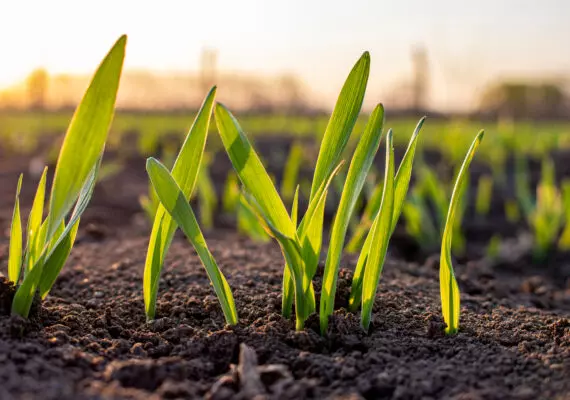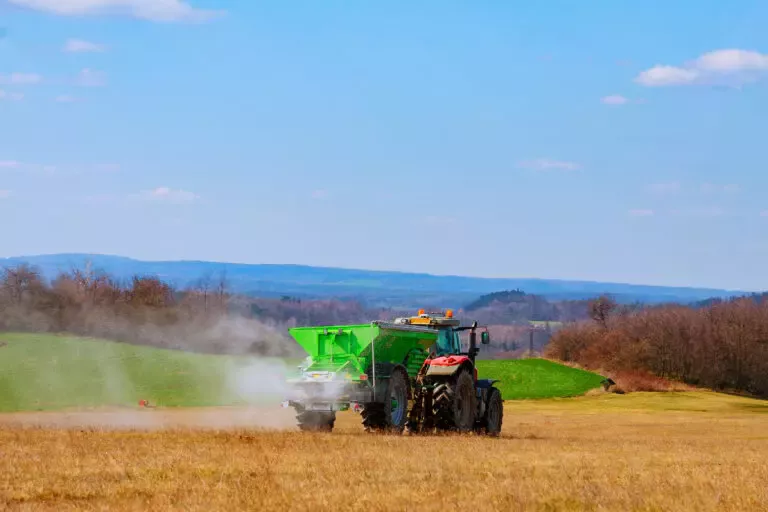
HOW TO FERTILIZE WINTER BARLEY?
Fertilizing winter barley requires careful attention. This plant develops its root system much less effectively, resulting in poorer water and nutrient uptake from the soil.
The key issue is proper soil preparation in autumn for winter barley cultivation. The most important aspect is adjusting the soil pH, which should be within the range of pH 6.0 to 7.5. When the pH is too low, winter barley may suffer from a deficiency of absorbable magnesium.
Additionally, plants face challenges in hardening and react poorly to the toxic effects of aluminum ions in the soil. Therefore, it is necessary to apply lime to the field at the very beginning.
There should be a gap of 4 weeks between liming the soil and applying subsequent fertilizers. Two weeks before sowing the plants, a seedbed plowing should be carried out to allow the soil to settle. This is also the right time to enrich the field with phosphorus and potassium.
The approximate nutritional requirements of winter barley to achieve a grain yield of 1 ton and an adequate straw mass are approximately:
- 23–26 kg of nitrogen;
- 11 kg of phosphorus;
- 22 kg of potassium;
- 7 kg of calcium;
- 4.5 kg of magnesium;
- 3.5 kg of sulfur;
- 5 g of boron;
- 9 g of copper;
- 260 g of iron;
- 70 g of manganese;
- 0.7 g of molybdenum;
- 60 g of zinc.
FERTILIZATION OF WINTER BARLEY WITH PHOSPHORUS AND POTASSIUM
Winter barley is extremely sensitive to phosphorus deficiency and also does not tolerate potassium deficiency well. The recommended dosages of these elements are:
- For phosphorus, about 50–90 kg/ha of P2O5;
- For potassium, about 60–120 kg/ha of K2O.
The best time to apply phosphorus-potassium fertilizers is during seedbed plowing, carried out 2–3 weeks before the planned sowing of winter barley.
Phosphorus helps winter barley develop a healthy root system, enabling better water and nutrient uptake. This element also promotes better flowering and grain formation in the spikes, resulting in higher yields.
Potassium plays a crucial role in winter barley nutrition. It regulates the plant’s water balance, improving its drought resistance. It also influences the density of cell sap, which translates into better wintering of the crop. Potassium also enhances the efficiency of nitrogen fertilization.
When determining the dosage of phosphorus and potassium fertilizers, soil test results should be considered. Based on these results, the content of these elements is determined, which may vary due to crop residues or remaining fertilizers.
FERTILIZATION OF WINTER BARLEY WITH NITROGEN
Fertilization with nitrogen for winter barley should be done in two or three doses. If the soil is not rich in nitrogen and the preceding crop is weak, no more than 20 kg of nitrogen per hectare should be applied in the pre-sowing period. If the soil is rich in nitrogen, the autumn dose can be omitted. Excessive amounts of this element in the initial growth phase of the plant could reduce its frost resistance and prevent winter survival. Nitrogen fertilization in winter barley cultivation is mainly applied in spring. It should be applied in two doses. The first nitrogen application should take place before the vegetation begins, with the recommended dosage being about 40–60 kg of nitrogen per hectare. The second fertilization of the winter barley field should be carried out when the plant is in the stem elongation phase. In this case, the dosage ranges from 50 to 70 kg of nitrogen per hectare.
FOLIAR FERTILIZATION OF WINTER BARLEY WITH MICRONUTRIENTS
The proper development of winter barley is also influenced by providing it with micronutrients, the deficiency of which can reduce yields. It is best to do this foliarly in the form of chelated fertilizer, in three doses. The first dose should be applied in autumn, the second at the end of the tillering phase, and the third during the heading phase of the plant. It is good practice to add 15% urea to the micronutrient fertilizer, which enhances the positive effects of the entire procedure.
Winter barley tolerates micronutrient deficiencies such as copper, manganese, molybdenum, and zinc very poorly. Copper helps in grain formation in the spike. This element also affects the stiffness of the stem and the mechanical strength of the plant. Thanks to copper, the cereal has increased resistance to fungal diseases. Manganese increases the plant’s resistance to drought and facilitates winter survival. It assists in protein synthesis and supports chlorophyll production. Thanks to molybdenum, winter barley utilizes nitrogen more efficiently. There is also an improvement in the transformation of this element. Zinc is a component of many enzymes in winter barley. It supports the proper physiological functioning of the plant.
LIMING THE FIELD FOR WINTER BARLEY
As mentioned earlier, winter barley is very sensitive to soil acidification. It achieves the best yields at a pH of 6.0 to 7.5. In acidic soils, plants have problems with hardening and winter poorly. Acidic soils are associated not only with a lack of calcium but also magnesium. Therefore, it is best to base fertilization on soil laboratory test results to know whether it is necessary to provide only calcium fertilizer or rather calcium-magnesium fertilizer.
Liming the arable field for winter barley should preferably be done after harvesting the preceding crop, before plowing. The dosage of lime or calcium-magnesium fertilizer must be determined based on the current soil pH test results. It is recommended for winter barley to use a dosage ranging from 500 to 1000 kg per hectare.
Notable lime and calcium-magnesium fertilizers are Polcalc III Generation and SuperMag. Both fertilizers can be applied with a tillage-seeding implement or broadcast spreader. They are made from ecological ingredients, without the use of binding agents, only water. They are well absorbed in the soil and quickly neutralize acidity, which is extremely important in winter barley cultivation.

AGROTECHNICAL TREATMENTS IN WINTER BARLEY FIELD
After harvesting the preceding crop of winter barley, the field should be plowed and harrowed to prevent soil from drying out. This will stimulate weed germination. After approximately 10 days, the field should be harrowed again to destroy emerging weeds. Two weeks before the planned sowing of winter barley, a seedbed plowing should be performed. Winter barley requires well-settled soil, which improves its wintering.
PROTECTING WINTER BARLEY FROM DISEASES
It is essential to protect the plants from diseases and pests in the cultivation of this cereal. The most common diseases of winter barley include:
- Yellow dwarf virus, transmitted by aphids;
- Snow mold;
- Powdery mildew;
- Net blotch.
The best methods for controlling the above-mentioned diseases are plant protection products and frequent crop monitoring. This allows for prompt remedial action.
WHAT NOT TO SOW AFTER WINTER BARLEY?
Winter barley grows well on soils previously cultivated with winter rapeseed, potatoes, peas, legumes for green fodder or dry fodder, and mixtures of vetches with rye. Winter barley should not be grown after wheat or barley. If it is intended for brewing purposes, its cultivation should not be preceded by leguminous and pea plants.






